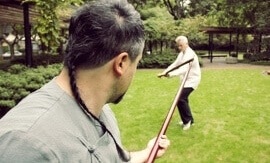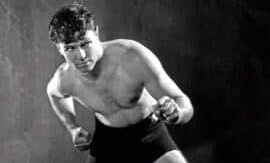
SIFU CHAU LIN FAT IS A VERY HUMBLE GENTLEMAN WITH GENUINE MARTIAL SKILLS AND A DEEP UNDERSTANDING. AT AGE 70, HE IS PASSIONATELY TEACHING A VERY EFFECTIVE WING CHUN APPROACH TO HIS STUDENTS.
When did you start training Wing Chun?
My passion for Wing Chun began while I attended a secondary school in Hong Kong and one of my neighbours introduced me to the art. However, it wasn’t until 1968 that I started studying it properly under my first Sifu, Wong Cze Wing—who was a direct student of the late Ip Man. He taught me a very “traditional” type of Wing Chun, which I trained up until 1981 when I encountered my second Sifu, Wan Kam Leung.
When I met Wan Sifu, he was in the transition to create his Practical Wing Chun, so many of the things he showed me were very innovative, and his methods completely changed my approach to Wing Chun. Nowadays, my Wing Chun is a well-rounded system based on traditional training, but with a modern approach.
Can you give us an overview of your system?
During the first six months, I teach a beginner the Siu Lin Tao form and the drills related to it including Chi Sao and basic stepping. After that, the student is taught Chum Kiu and finally Biu Jee—of course, only when the student is ready for it. The training on the Wooden Dummy will start soon after the student has finished learning the Biu Jee form. My school is not particularly big, so for Long Pole and Knives training, we have separate classes available.
How do you interpret each of the empty-hand forms?
Siu Lin Tao teaches you the basics of the system and how they are applied at close-range, angles and positioning. Chum Kiu teaches you how to move the body and focus on the waists, elbows, and shoulders to deliver substantial power, as well as stepping to chase the opponent.
Biu Jee is for very close and out of reach distance combined together and teaches the most aggressive techniques to quickly get out of difficult situations. Understanding the forms and their purposes is really important. If you don’t understand the forms, you can’t truly apply the principles under pressure in a real fight.
What are the main differences between “traditional” Wing Chun and what you teach?
The main difference is the stance balance in the position. While it’s obvious that you shouldn’t lean forward, some Wing Chun styles lean backwards in order to be positioned further away from the opponent to naturally avoid his or her attacks—but at the same time, they can’t attack as well by doing so. I use a balanced 50/50 weight distribution in all my positions in order to gain a lot more mobility—instead of being in a passive position.
Do you consider strength and conditioning to be important?
No matter how good your techniques are; if your body can’t support them then it’s completely useless. You need to have power in your punch to stop your opponent! Techniques and body conditioning are both important, and you should include both of them in your training.
Do you use the wall-bag in your training?
I believe is important to use the wall bag in order to improve focus and elbow power in the punch, however, it has to be done gradually otherwise it can cause painful injuries or bad habits. I teach many different ways to punch the bag—using, at first, only the hands, and then the whole body.
Has your personal approach to Wing Chun changed over the years?
When I was younger I used a lot of power, but at my age, I have to be more relaxed and technical otherwise the Ging (Relaxed Power) will not come out effectively. I have come to realise that relaxation is the “secret” to Wing Chun. You can also not allow Wing Chun to change who you are—you have to step out the box and improve according to your knowledge and ability in order to make Wing Chun your own, and unique to whom you are.
MMA is becoming very popular nowadays. Do you believe Wing Chun to be a complete system or should we also look somewhere else?
A lack of deep knowledge might bring some people to look elsewhere. I don’t teach ground fighting because I teach Wing Chun, but it’s true that you have to be alert and your hand techniques have to be flawless and fast, so people can’t easily get close to you. Structure, stepping and positioning are our system’s strengths and we need to use them in order for the opponent to play our game. We don’t want to play his/hers—otherwise, we can’t win. Wing Chun is a very comprehensive system, and I don’t believe in adding to it, but instead to perfect what it is already there.
Do you believe kicks are an important part of the system, and how do you train them?
I let my students kick the Wooden Dummy as well as wall bags hanging at different heights, and sometimes I let them do partner drills. However, I usually let them focus more on the hand techniques—after all, Wing Chun is a close range combat system and there’s a limited amount of kicks you can use at close distance when compared to hand techniques. Balance at close range is also another issue to consider when delivering powerful kicks in a fight.
We live in the time of the internet and many people use Sifu YouTube to “learn” Wing Chun. what are your thoughts about that?
I come from an era where Biu Jee was very much a closed-door form, but nowadays people want to learn the system as fast as possible. Wing Chun is based on principles and concepts, so it is clearly impossible to learn it from a video. There are so many things going on—joint handling, precise angles and body movement—that you simply can’t learn it virtually; even from a very detailed video or book. A video can be a good reference when you already know the forms, etc. However, I strongly suggest everyone to learn Wing Chun from a qualified Sifu.
What are your thoughts on the Long Pole and the Knives?
The weapons are useful tools to improve your angles and body connection in order to deliver power. The weapons teach you how to connect your waist, improve your mobility and positioning, strengthen and make the wrists more flexible, and help to release shoulder power. They are deemed invaluable tools to develop the physical aspect of the system.
Do you wear protective gear during sparring?
I don’t think you should wear protective gear but train freely like in a real situation. When you wear protective gear you will not worry about getting hit and blindly move forward, careless of possible damage. By not using protective gear, your mind and focus will be more attentive and that will hugely improve your reactions.



















